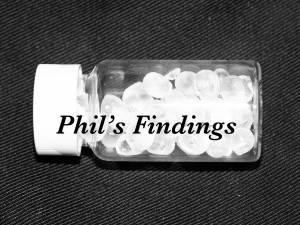Phil’s Findings #4: Psychophysics!
13 June 2011

Phil Howes, the Institute of Making’s post-doc researcher, shares his thoughts and findings as he delves into the sensoaesthetic world of materials. Check this space every Monday for Phil's latest posting.
Since I started work at the Institute of Making I’ve had quite a few conversations along the lines of the following. I’ll be asked “So what are you studying now?”, to which I reply “Psychophysics”, and I almost always get an answer along the lines of “What on earth is that?”. One person even replied with “Why do you keep calling it that? Doesn’t it have a proper name?”. I think the confusion is that people presume the ‘psycho’ in psychophysics stems from psychopathic, rather than simply from psychology.
So what is psychophysics? Well, it’s basically the use of quantitative measurement techniques applied to the study of sensation and perception. For this reason, it is often referred to as ‘the science of the senses’. Although the concept may sound simple enough, the actual execution of these measurements is really quite complicated. Think about it. How can someone actually measure how brightly you see a light, how loud you perceive a sound, or how strongly you can smell a smell? Furthermore, how can we compare how strongly I perceive the same stimuli that you are experiencing? The stimulus can be measured scientifically, but what about the perception? Well, surprisingly it is actually possible to make these measurements, and even to formulate mathematical laws which govern the senses.
Measurements of perception can be performed by studying ratios rather than absolute values. This means that instead of measuring perception directly, you can give a person two stimuli and ask them how they compare. For example, you may ask someone to look at a light. You can then increase the intensity of the light, and ask the subject how strong the light is in relation to the first light. You can do this for a whole bunch of different intensities to build up a graph of how light intensity (a physically measurable quantity) relates to perceived brightness (a psychophysical quantity). From this graph you can then work out a mathematical model for the data. This system of measurement by ratios seems pretty simple, however it was a long time coming, and much debate and confrontation preceded it. An American psychologist from Harvard named Stanley Stevens (1906-1973) was at the forefront of this debate, and did a huge amount to develop many new methods of psychophysical measurement techniques. He revived the previously rejected ‘power law’ (now called Steven’s power law in his honour) which states that the relationship between perception and stimulus can always be described by a power function. He developed new methods of magnitude estimation, magnitude production and cross modality matching to create psychophysical scales, and published a large body of work in support of his ideas. Stevens’ work changed psychophysics, and the subject is built on the foundations that he and a few of his predecessors laid. Furthermore, because psychophysics has a strong emphasis on quantitative measurement, techniques developed within the field have been applied to various other problems such as learning, memory, attitude measurement, and social psychology.